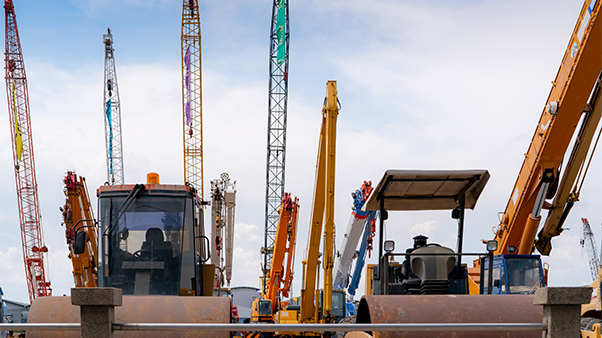
In the world of construction and heavy lifting, cranes stand tall as indispensable tools. However, behind every successful crane operation lies a crucial element – rigging equipment. Rigging plays a pivotal role in ensuring the safe and efficient lifting of heavy loads. Let’s delve into the essential rigging equipment used for cranes and understand their significance in lifting operations. Cranes play a vital role in construction and heavy lifting operations, making them indispensable on job sites. However, the efficiency and safety of crane operations heavily depend on the rigging equipment used. Rigging is a critical aspect of crane lifting, ensuring that the load is securely attached and lifted without any mishaps. In this blog post, we’ll delve into the essential rigging equipment used for cranes.
Wire Rope Slings:
Description: Wire rope slings are the backbone of crane rigging. Composed of high-strength steel wires, these slings provide durability and flexibility. They come in various configurations, including single-leg, double-leg, and multi-leg options.
Application: Ideal for lifting loads with irregular shapes, wire rope slings offer versatility and strength. Proper inspection and maintenance are crucial for their longevity and safety. Wire rope slings are one of the most common and versatile types of rigging equipment. Composed of strong steel cables, these slings provide flexibility while maintaining robust lifting capabilities. They come in various configurations, including single-leg slings for vertical lifts and multi-leg slings for more complex load distributions.
Shackles:
Description: Shackles are robust, U-shaped metal connectors used to secure slings and other rigging components. They come in different designs, such as screw pin and bolt-type, anchor and chain shackles, each catering to specific applications. Shackles are crucial components in rigging, connecting various elements of the lifting system.
Application: Shackles are vital for connecting various rigging elements, creating a secure link between the load and the crane. Proper load alignment and shackle selection are imperative for safe lifting.
Synthetic Slings:
Description: Synthetic slings, made from materials like nylon and polyester, provide a lightweight alternative to wire rope. They are flexible, easy to handle, and resistant to chemicals and UV rays.
Application: Commonly used for delicate loads or in environments where wire rope may not be suitable, synthetic slings offer a gentler approach to lifting without compromising strength. For applications where weight and flexibility are crucial, synthetic slings made of materials like nylon or polyester are preferred. These slings are lightweight, easy to handle, and offer excellent load-bearing capabilities.
Hooks:
Description: Hooks are essential components that attach to the load for lifting. They come in various types, such as clevis hooks, eye hooks, swivel hooks and grab hooks, each designed for specific applications and are the primary connection point between the crane and the load. Proper inspection and maintenance of hooks are vital for crane safety.
Application: Selecting the right hook for the job is crucial for load stability and safety. Regular inspections and proper maintenance ensure that hooks remain in optimal condition.
Master Links:
Description: Master links are large, strong connectors that join multiple slings or chains to the crane hook. They provide a central point for distributing load weight evenly.
Application: When lifting heavy or oversized loads, master links play a critical role in maintaining balance and preventing uneven stress on rigging components.
Chain Slings:
Chain slings are a versatile and durable piece of heavy lifting equipment that can be used in a wide range of industries. They are flexible, resistant to abrasion, temperature resistant, and strong enough to handle a wide array of loading conditions, making them ideal for challenging environments.. When choosing a chain sling, you can consider things like the maximum load to be lifted, the shape of the load, and the size of the sling and leg assembly.
Rigging Hardware:
Rigging hardware is a broad category of equipment used to lift, suspend, hoist, secure, lash, tow, and anchor loads. Various rigging hardware, including turnbuckles, eyebolts, and links, are used to create a secure and stable lifting configuration. Proper selection and use of rigging hardware are essential for maintaining load stability.
Load Cells:
Load cells are used to measure the weight of the load being lifted. Load cells are sensors that can translate pressure into an electrical signal. They can be used to measure and monitor the tension of loads involving wire rope, guy wire, synthetic rope, shackles, and more. They provide crucial information to crane operators, ensuring that the load stays within the crane’s capacity.
In conclusion, mastering the art of rigging is essential for safe and efficient crane operations. The proper selection, use, and maintenance of rigging equipment are paramount to prevent accidents and ensure a smooth lifting process. As cranes continue to evolve, so does the importance of understanding and implementing the right rigging techniques and equipment. Rigging is not just a part of the process; it’s the key to success in the world of heavy lifting. In the world of crane operations, understanding and utilizing the right rigging equipment is paramount for safety and efficiency. Rigging failures can lead to catastrophic consequences, emphasizing the importance of proper training, inspection, and maintenance. By investing in high-quality rigging equipment and following best practices, construction professionals can ensure the success of their lifting operations while prioritizing the well-being of their teams.
Leave a Reply